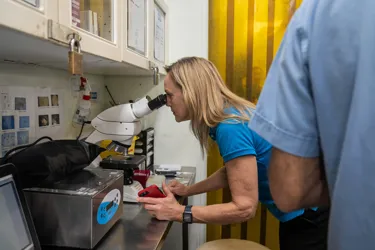World-First Reproductive Technique Provides Hope for Endangered Wild Shark Populations
- Tuesday 17th December 2024
- Conservation

SEA LIFE Sydney Aquarium is thrilled to announce its involvement in an exciting, world-first development in shark science and conservation, as their female leopard shark (Stegostoma tigrinum) population have been artificially inseminated with sperm collected from wild male leopard sharks.


This significant milestone is part of the pioneering Great Australian Stegostoma Semen Expedition (GASSE) initiative, which aims to boost shark populations and genetic diversity through cutting-edge reproductive science.
The week-long GASSE expedition took place last week, off North Stradbroke Island in Queensland, Australia. A team of 15 scientists, aquarium experts and veterinarians from the StAR Project and partnering institutions collected semen from wild Indo-Pacific leopard sharks. This innovative technique is designed to increase egg production and the genetic diversity of fertilised eggs, which is critical to the ongoing success of repopulation programs such as the StAR Project (Stegostoma tigrinum Augmentation Recovery Project), aiming to rewild leopard sharks.
"The successful artificial insemination at SEA LIFE Sydney Aquarium marks a major leap forward for shark conservation," said Laura Simmons, Head of Conservation, Welfare and Education for SEA LIFE in Australia and New Zealand. "By using this revolutionary method, we are supporting the future of the leopard shark populations in our care whilst bolstering global efforts to preserve these magnificent creatures in the wild."


The sperm collected during GASSE will be used for artificial insemination in female leopard sharks housed in aquariums across Australia and Singapore. Once the eggs are laid and known to be fertile, they will be sent to Raja Ampat, Indonesia, as part of a collaborative recovery project. This rewilding effort, aimed at replenishing shark populations in their wild habitat, is a critical component of long-term conservation strategies for endangered and at-risk species like the leopard shark.
Together with SEA LIFE Sydney Aquarium, GASSE is supported by a range of global partners, including Conservation International, 香港海洋公園 Ocean Park Hong Kong, Sea World - Gold Coast, The University of Queensland, Moreton Bay Research Station, S.E.A. Aquarium, Thrive Conservation and Biopixel Oceans Foundation. Their combined efforts and expertise are creating a new blueprint for shark conservation that could eventually be applied to other shark and ray species.


As the GASSE project continues to unfold, the SEA LIFE Sydney Aquarium team remains committed to advancing the science and conservation of marine life, playing an instrumental role in this groundbreaking endeavour.
For more information, please visit: www.visitsealife.com/sydney/conservation/local-conservation-projects/the-star-project
